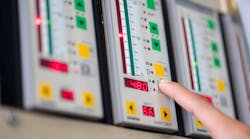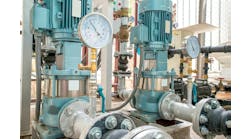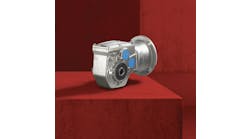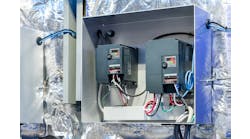Variable-frequency drives (VFDs) are an energy-efficient means of controlling motors in industrial applications. A VFD converts alternating-current (ac) power into direct current (dc) using a rectifier and then uses an inverter to convert it back to ac, connecting the power source to the motor with energy-efficient torque control.
“In a typical induction-motor application, the VFD adjusts the frequency proportionally to the speed set point and also regulates the magnitude of the voltage in proportion to frequency to maintain the torque characteristics of the motor,” explains Rob McNair, P.Eng., senior electrical engineer at Teck Metals.
A VFD is also known as a variable-speed drive or an adjustable-frequency drive.
Voltage magnitude refers to its intensity by measuring the potential difference between two points in a circuit. An ac circuit's voltage magnitude can change over time, creating a sine wave, or sinusoidal waveform, with peak voltage that can be measured at its highest point of voltage in the cycle. Devices have unique voltage-level requirements, so the voltage magnitude must be maintained to ensure safety and reliability.
How does a VFD work?
The ac power supplied to a VFD is converted into dc using a rectifier circuit within the drive, which changes the voltage level to match the motor’s requirements. The rectified power is stored in a dc bus, also known as a link or capacitor bank, which provides the stable source for the inverter, which then turns the dc voltage into high-frequency pulses that are controlled by the VFD. The inverter uses pulse-width modulation (PWM) to create the controlled output waveform.
Once the pulses are filtered to reconstruct the ac waveform, the output can be adjusted and sent to the electric motor. A VFD has built-in control circuits and algorithms, which allow operators to set the desired speed and acceleration. Some have the ability to support external control through analog signals, digital inputs or communication protocols such as Modbus or Profibus.
What is the advantage of a variable-frequency drive?
Because they’re able to optimize speed, VFDs allow motors to run at lower power, saving energy.
The control of motor speed and torque means smoother startups, more precise positioning and adaptability to process changes. The controlled acceleration and deceleration provided by a VFD also reduces wear on motors and the machinery they power.
A VFD’s ability to provide soft starts and stops mitigates the mechanical strain and stress on components such as gears, couplings and belts.
Variable-frequency drives are common in industrial processes such as pumps, compressors and conveyance systems. Because of their energy efficiency, VFDs are often found in heating, ventilation and air-conditioning (HVAC) equipment and water-treatment facilities, as well as renewable-energy components such as wind turbines and solar tracking systems and inverters.
What is a variable-frequency drive used for?
In addition to pumps, conveyors and energy equipment, VFDs are beneficial in controlling the rotational speed of agitators or mixers, ensuring repeatable quality while conserving energy, especially when operating at lower speeds. Using a VFD to run motors at lower speeds reduces the need for throttling valves or dampers, which lowers heat generation. This can be significant in areas where temperature is an issue.
Plastics manufacturers use extruders for shaping materials, so precise control of extrusion maintains a high level of quality. The VFD is an ideal enabler of the extrusion process.
Centrifuges are common in pharmaceutical manufacturing and wastewater treatment for material separation. The centrifuge speed can be controlled by VFDs to ensure process and energy efficiency.
Another beneficial application of VFDs is in machine tools such as grinders, lathes and mills, where spindle speed needs to be controlled for precision machining.
Variable-frequency drives are used to control the speed of rollers to maintain tension in textile and paper equipment.
Besides conveyance and pumps, mixers used in the food-and-beverage industry benefit from VFDs’ ability to control speed and ensure consistency.
What are the benefits of a variable-frequency drive?
Variable-frequency drives are common in industrial applications because they can reduce motor speed when it’s not needed, saving energy. They also enable precise performance and speed control for reliability, repeatability and consistency.
One of the VFD’s biggest benefits is its ability to provide soft starting and stopping of motors, reducing mechanical stress on not just the motors, but also on all connected equipment.
Load matching is another benefit, especially in applications, such as cranes or lifts, where the load varies, ensuring consistent power and speed, despite changing load conditions. In some applications, electrical energy can even be regenerated back to the grid when a motor decelerates or operates in reverse.
A VFD also can improve a system’s power factor, optimizing power use and mitigating demand charges. Using VFDs in place of fixed-speed motors reduces the physical footprint of power devices in the control panel, too. They also can simplify wiring needed, compared to a motor starter, which needs to be connected with separate control devices.
Despite its many advantages, a VFD requires proper sizing, installation and maintenance.
What is the difference between a VFD and a motor starter?
A VFD can be used to replace a motor starter, but some key considerations must be addressed before making a switch from one to the other.
A motor starter uses contactors or relays to turn a motor on and off. It also includes overload protection. However, it has no control of the speed of the motor.
Conversely, a VFD can start and stop a motor and control its speed and torque, allowing the operator to vary the frequency supplied to the motor for smoother acceleration and deceleration.
Because they can vary motor speed to match load requirements, VFDs are able to operate more efficiently, reducing power consumption. And their ability to provide soft-start and soft-stop capabilities reduces the amount of mechanical stress, which can extend the life of the motor and all connected equipment.
Variable-frequency drives are predictably more expensive than basic motor starters, but initial cost can be justified by the energy savings and improved control of the VFD.
Not all motors can be controlled by VFDs, so it’s critical to determine compatibility beforehand. The motor and the load may not respond well to variable speed, so be certain to do your homework.
Unlike a motor starter, a VFD requires programming to set up parameters. Its maintenance also requires more specialized expertise than motor-starter maintenance does.
You've read the article, now it's time to test your knowledge.





